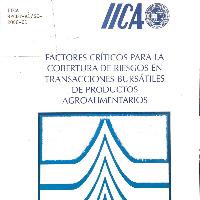Resumen
- Empirical research using optimal hedge ratios usually suggests that producers should hedge much more than they do. In this study, a new theoretical model of hedging is derived. Optimal hedge and leverage ratios and their relationships with yield risk, price variability, basis risk, taxes, and financial risk are determined using alternative assumptions. The motivation to hedge is provided by progressive tax rates and cost of bankruptcy. An empirical example for a wheat and stocker-steer producer is provided. Results show that there are many factors, Often assumed in the literature, that make farmers hedge little or none. Progressive tax rates provide an incentive for farmers to hedge in order to reduce their taxes liabilities and increase their after-tax income. Farmers will hedge when cost of hedging is less than the benefits of hedging Is less than the benefits of hedging which come from reducing tax liabilities, liquidity costs, or bankruptcy costs. When tax loss carry back is allowed, hedging decreases as the amount of tax loss carried back increases.Higher profitability makes benefits from futures trading negligible and hedging unattractive, since farmers move to higher income brackets with near constant marginal tax rates. Increasing basis risk or yield risk also reduces the incentive to hedge.
